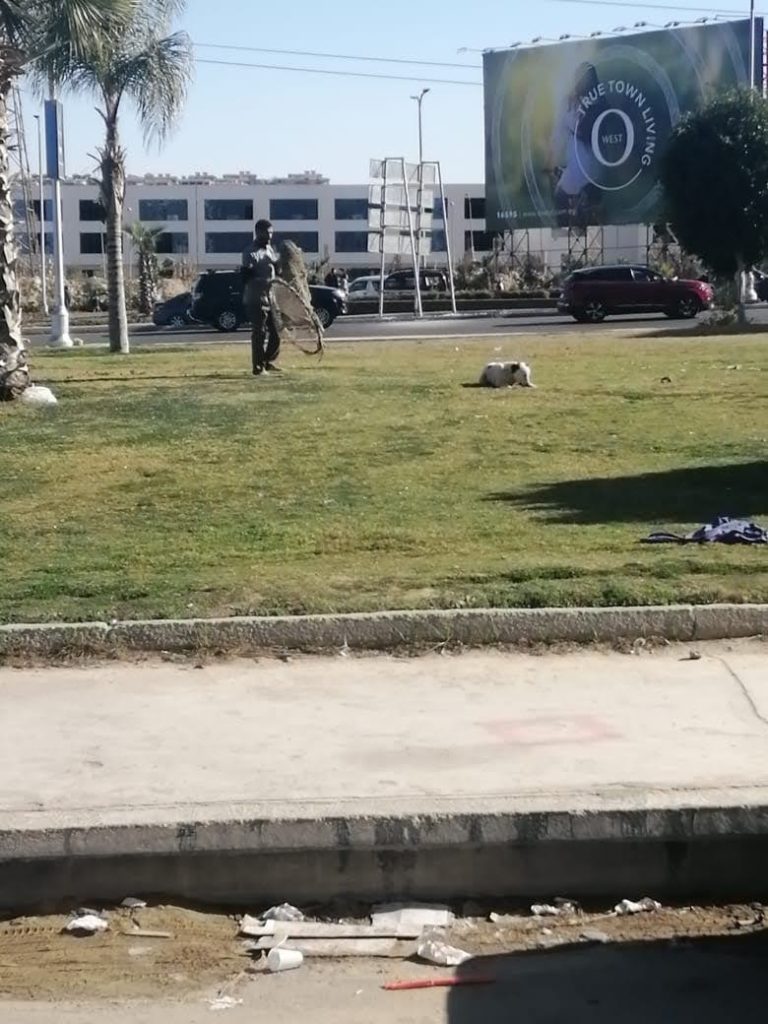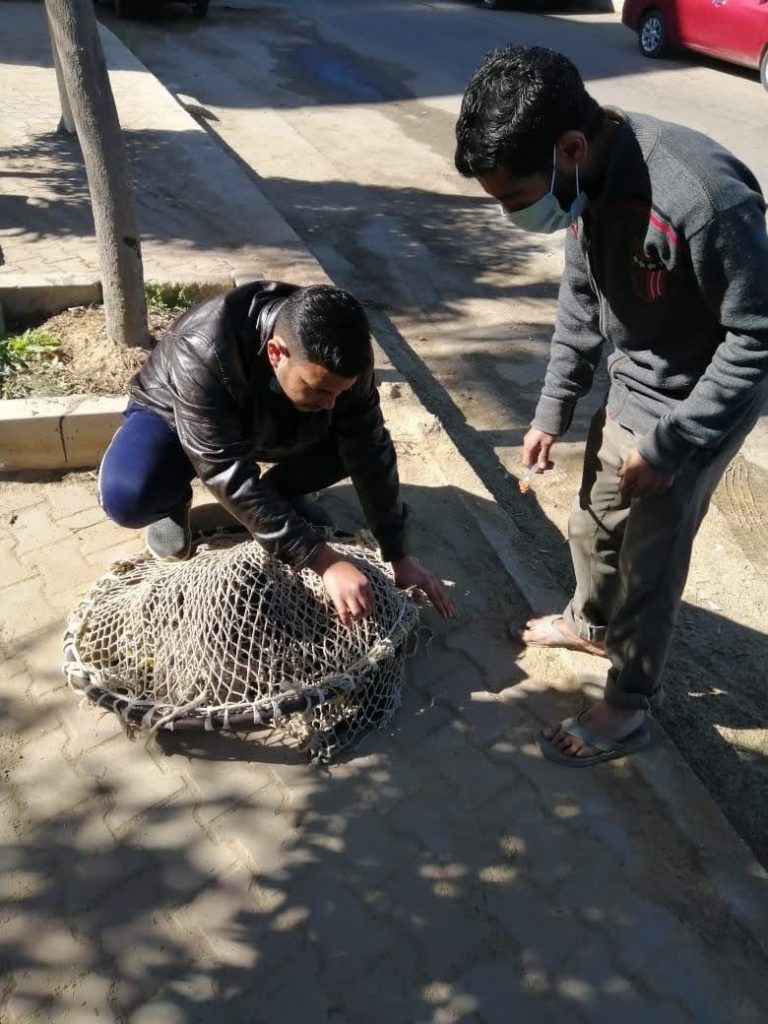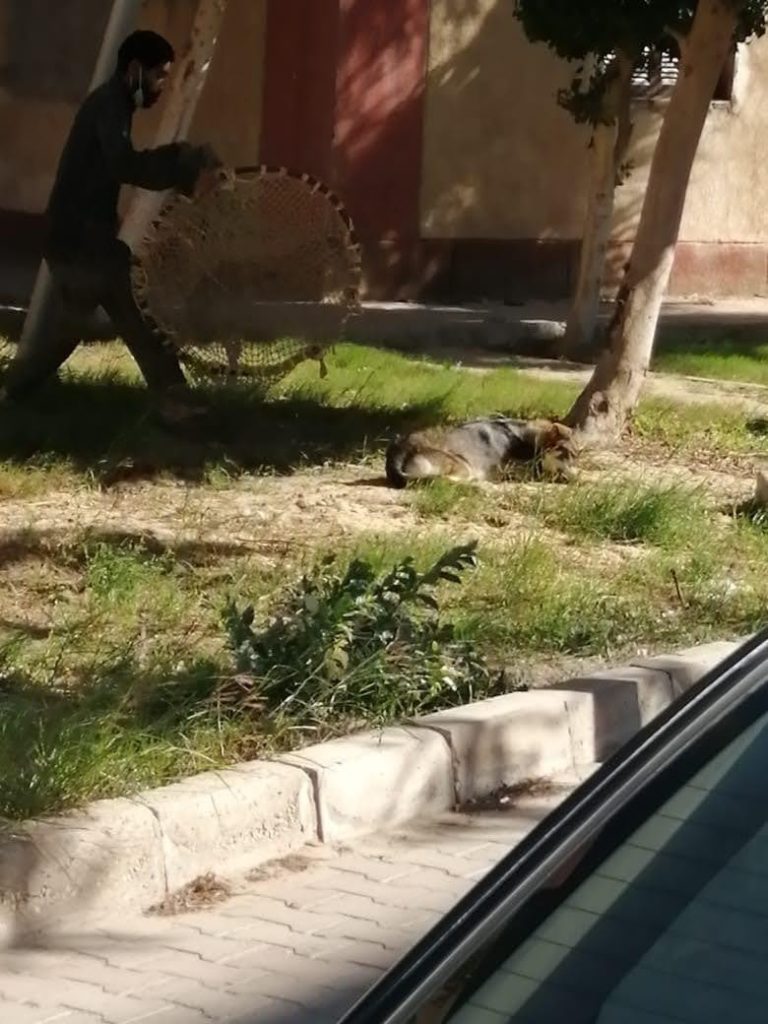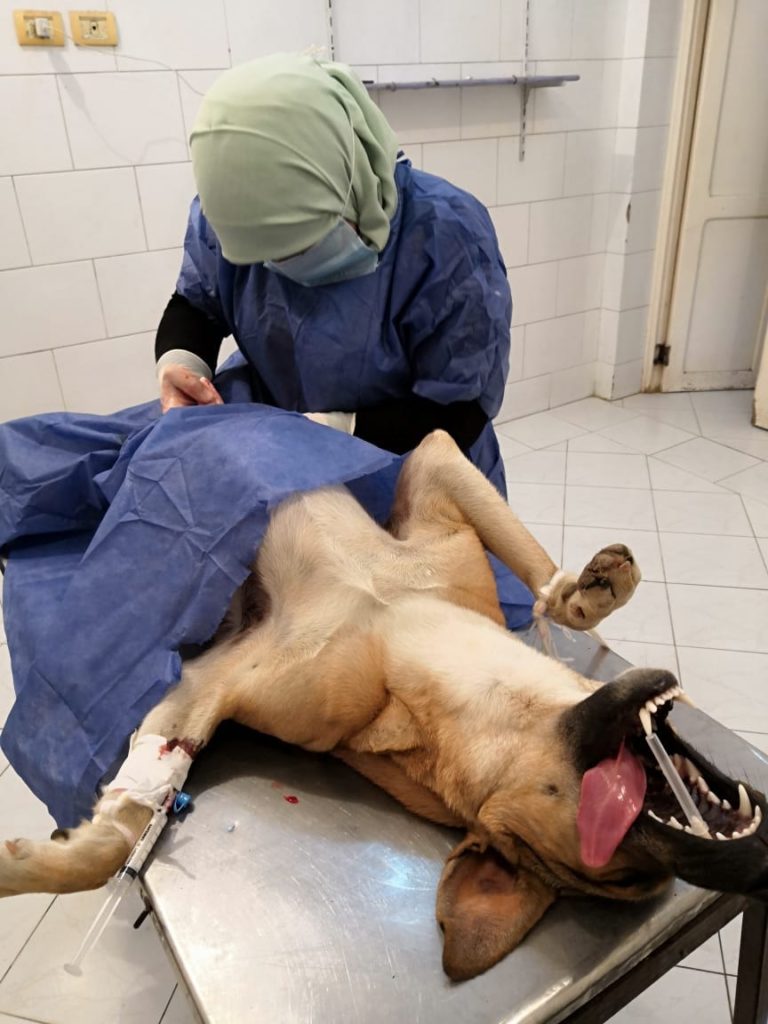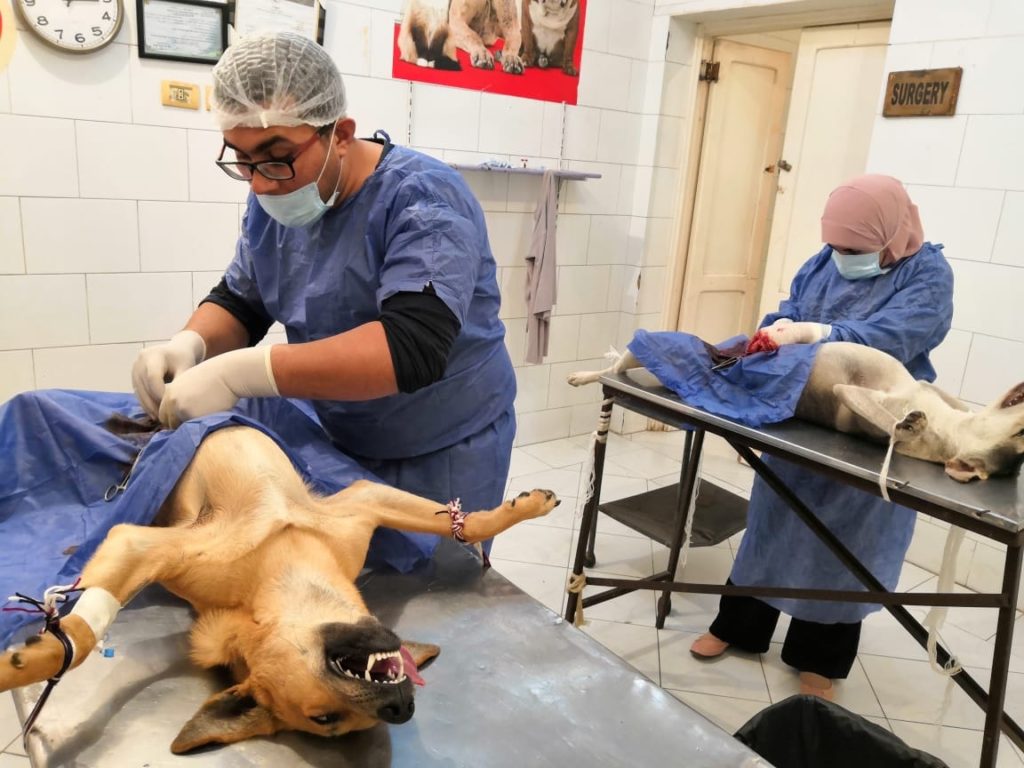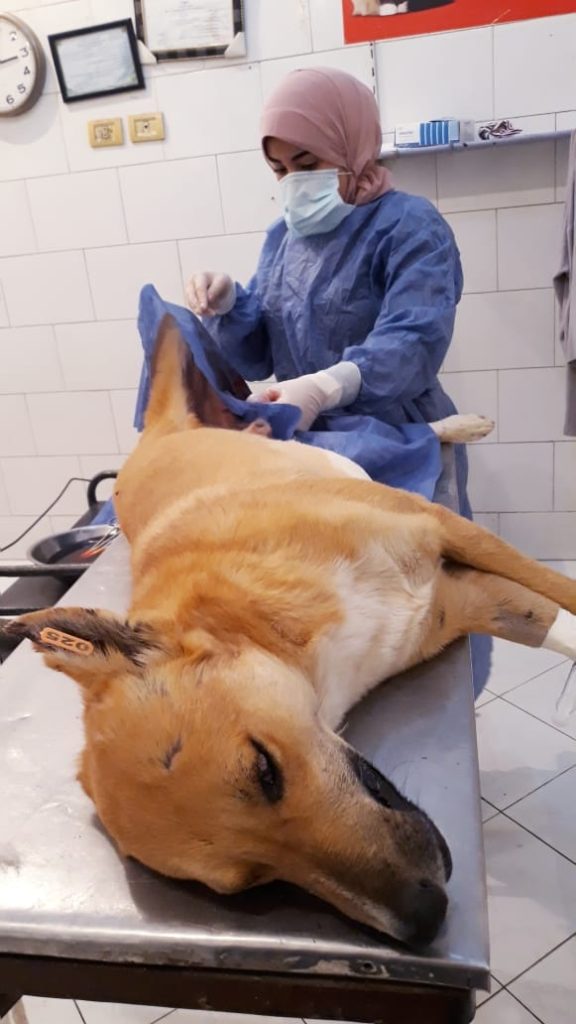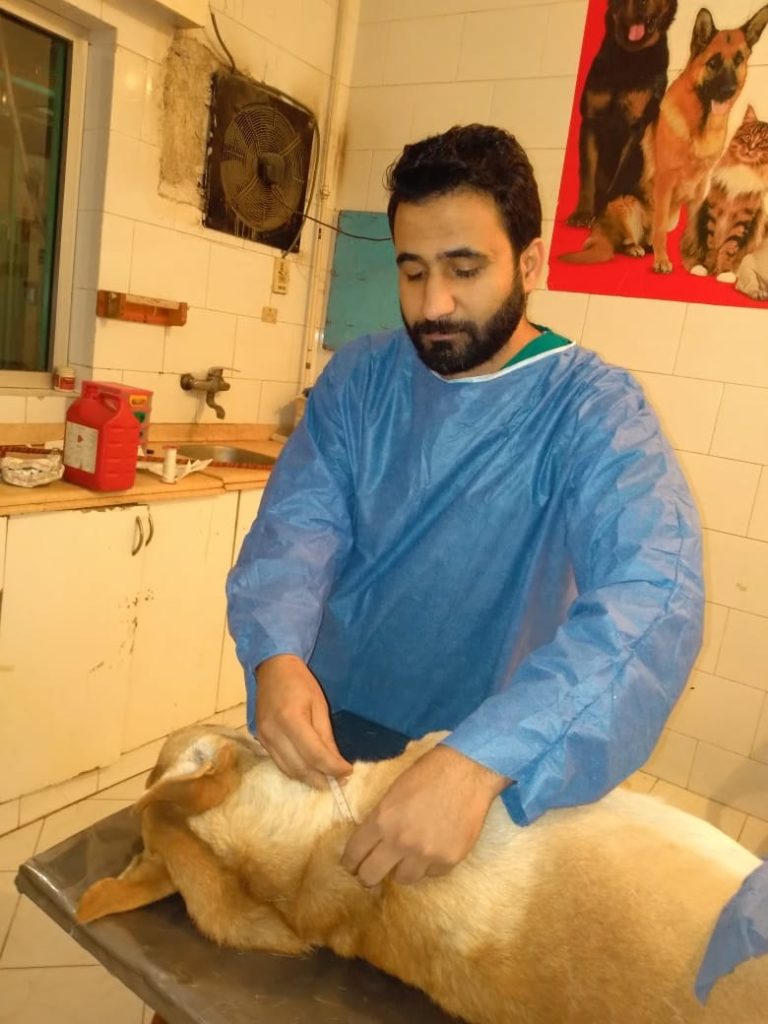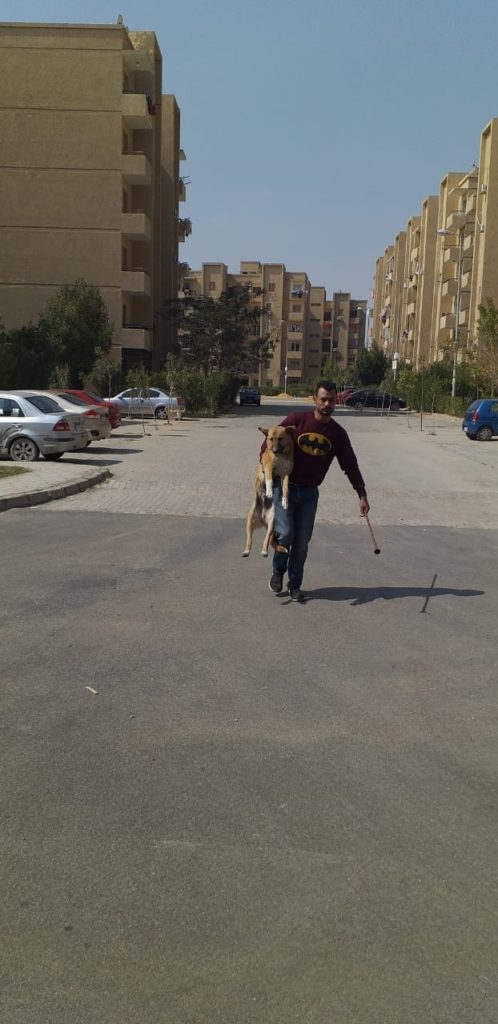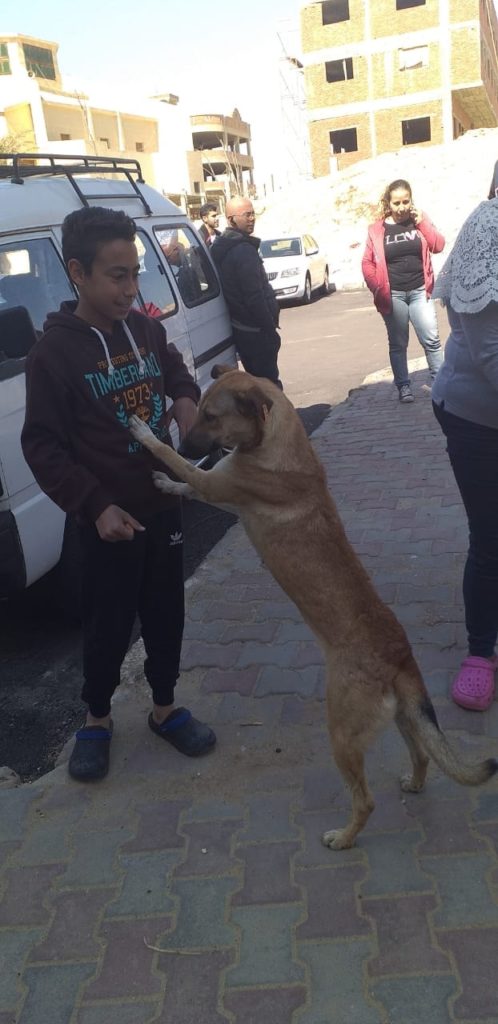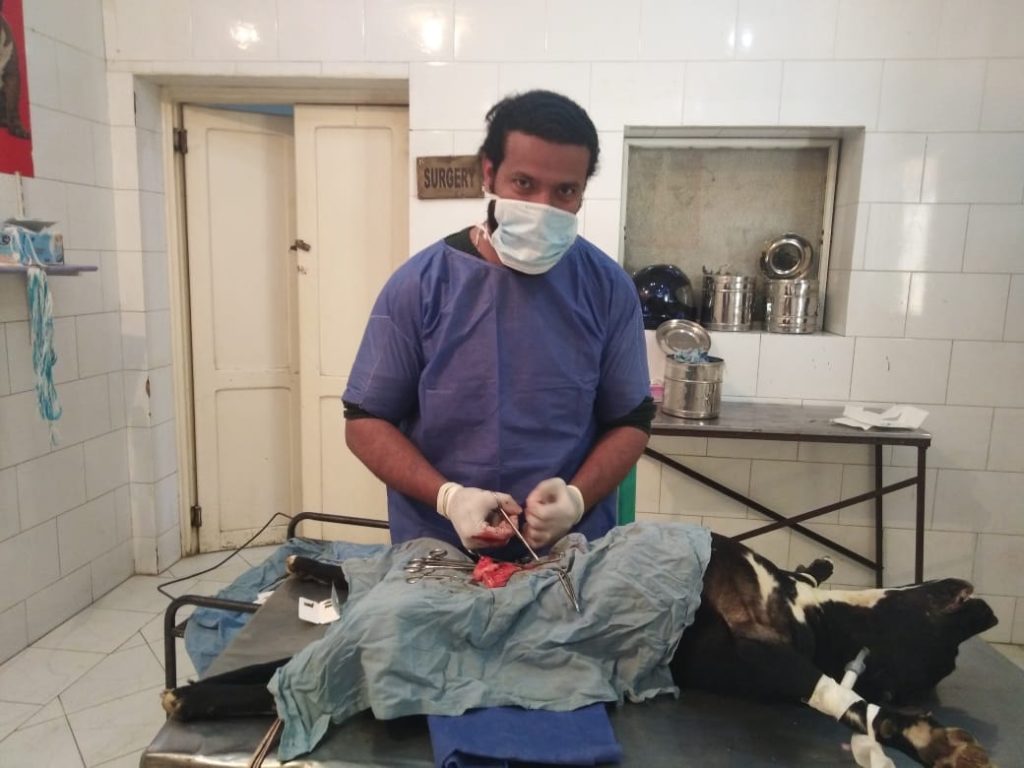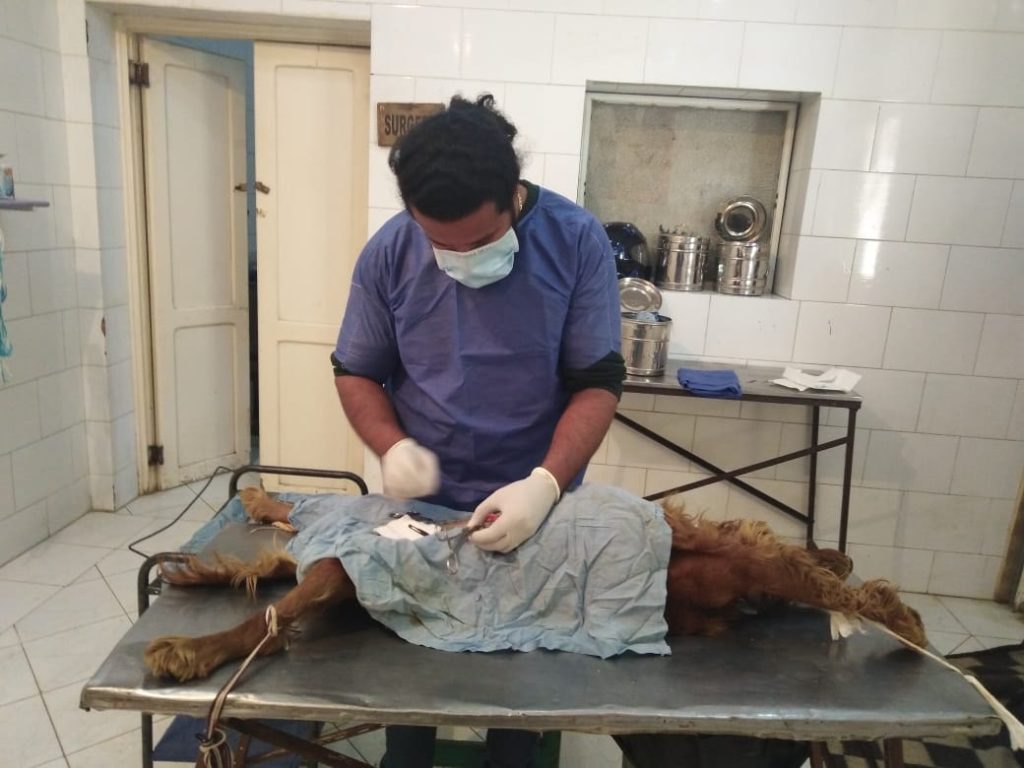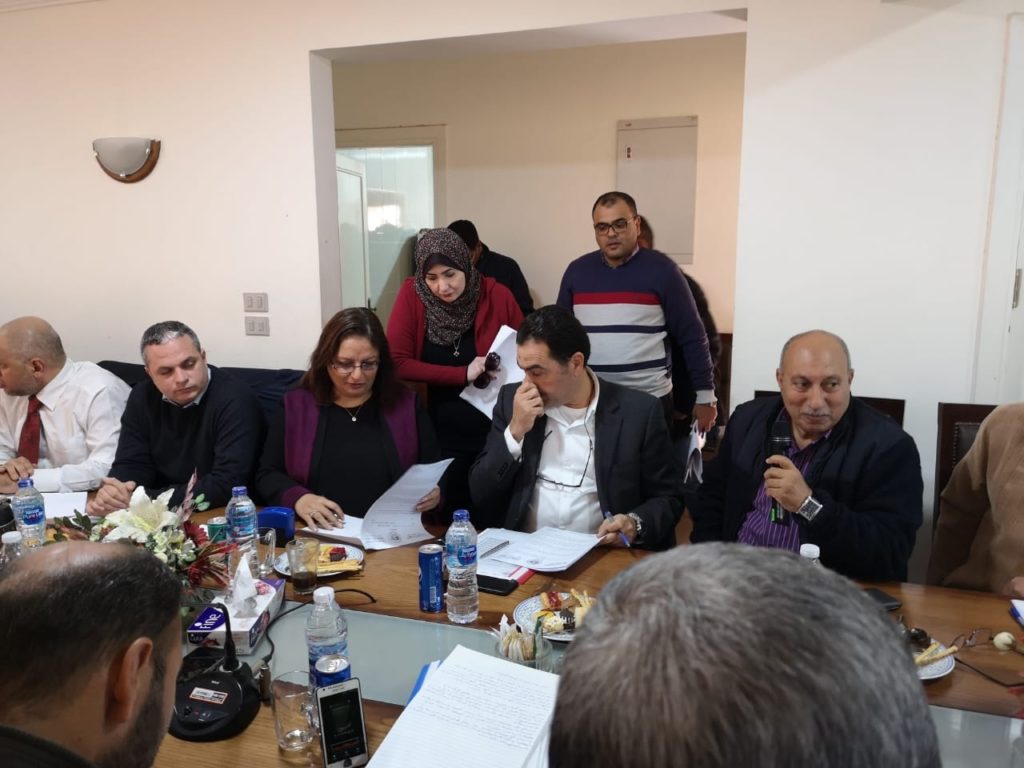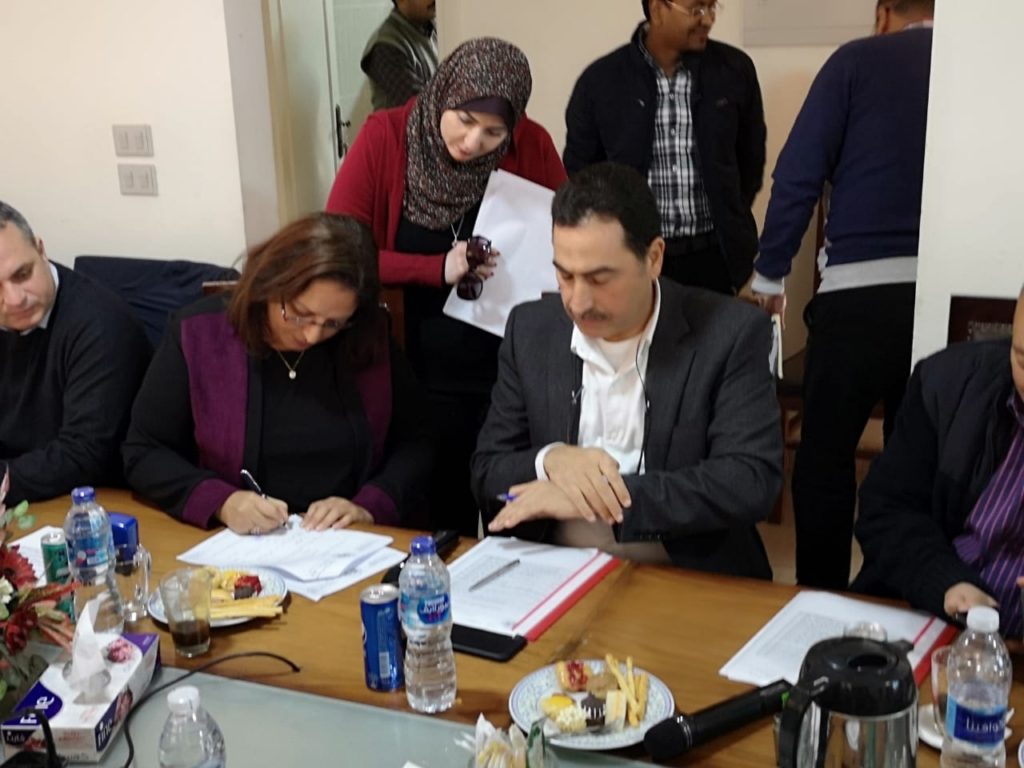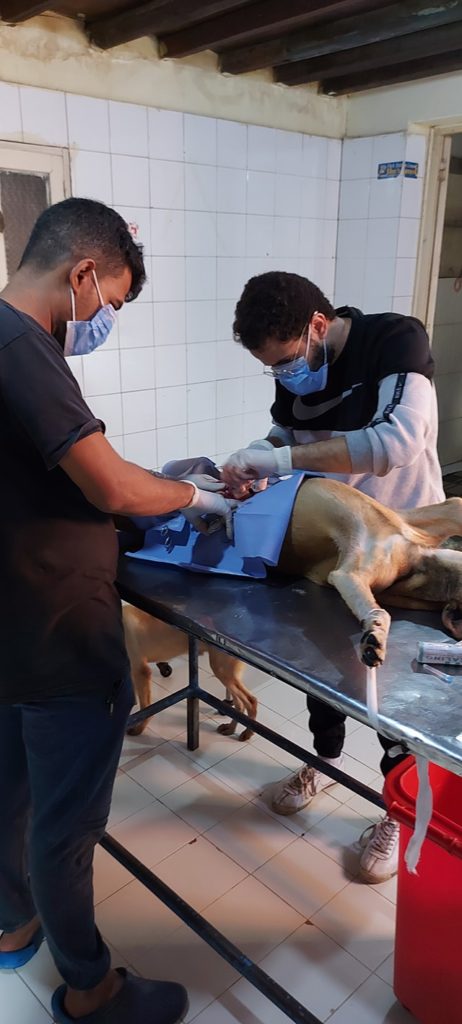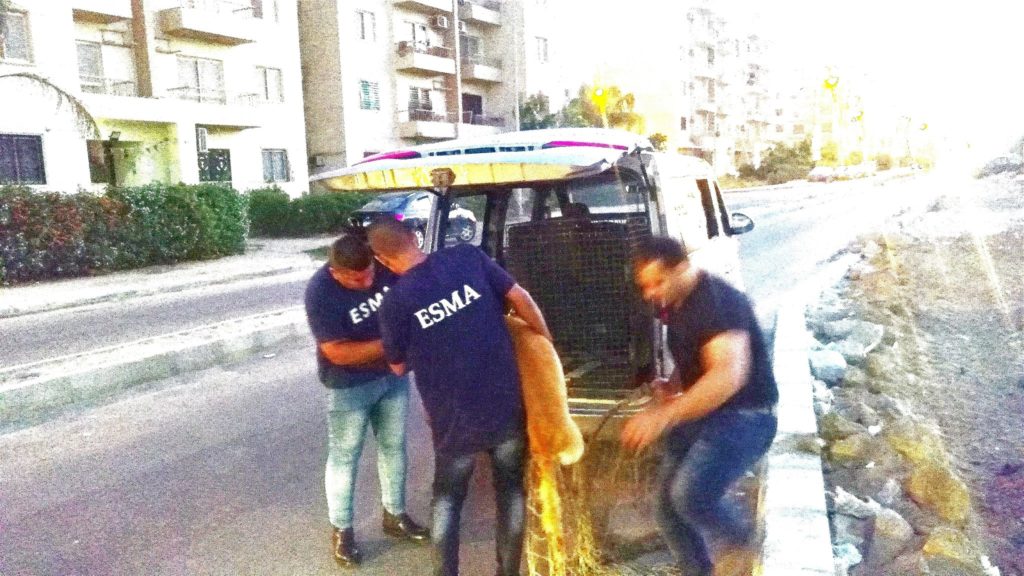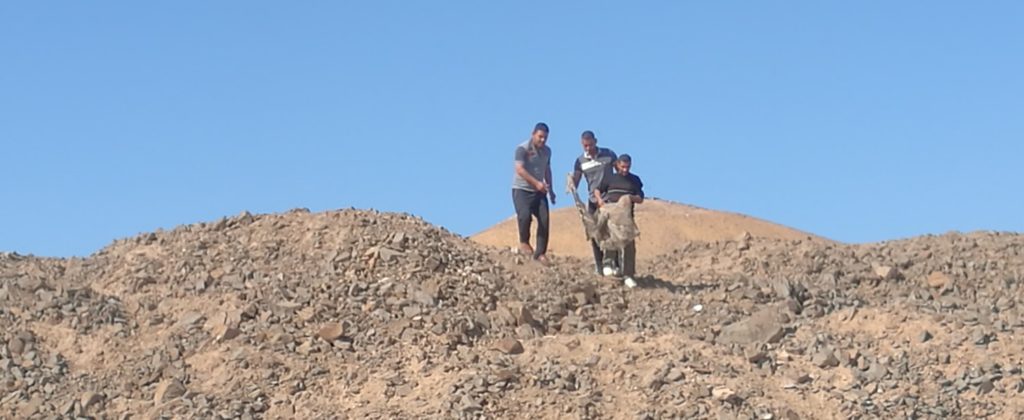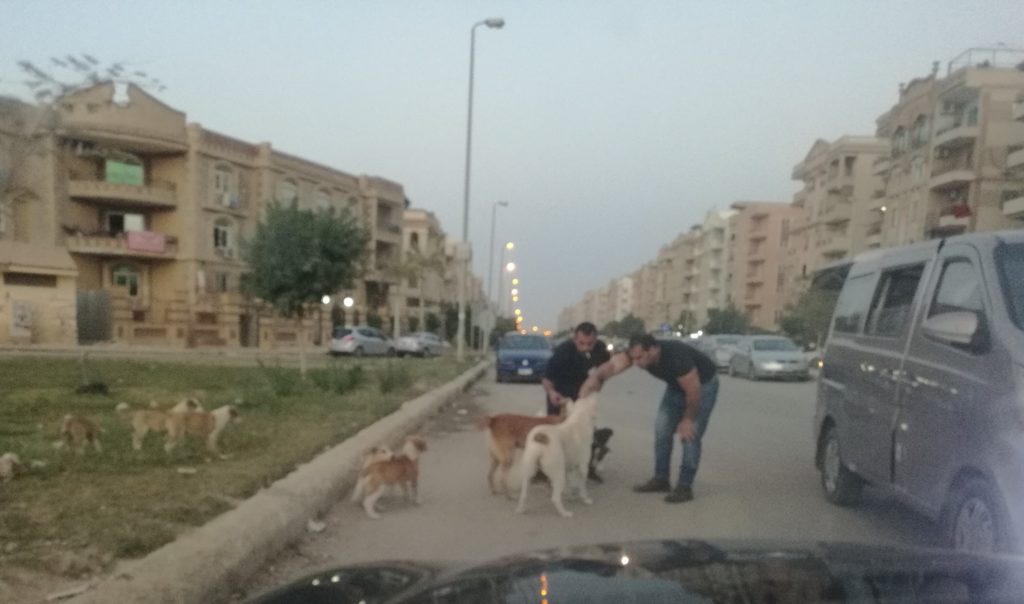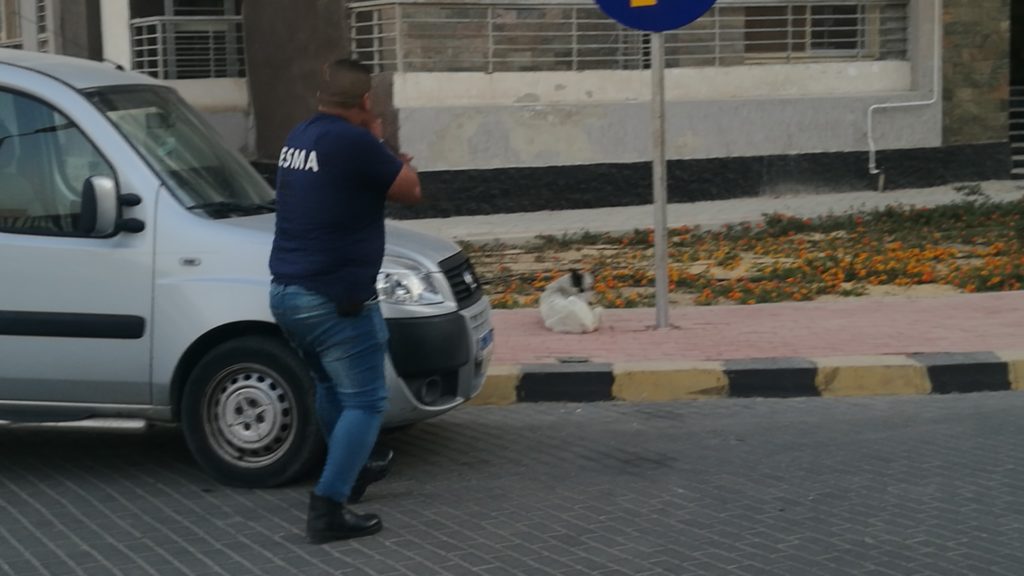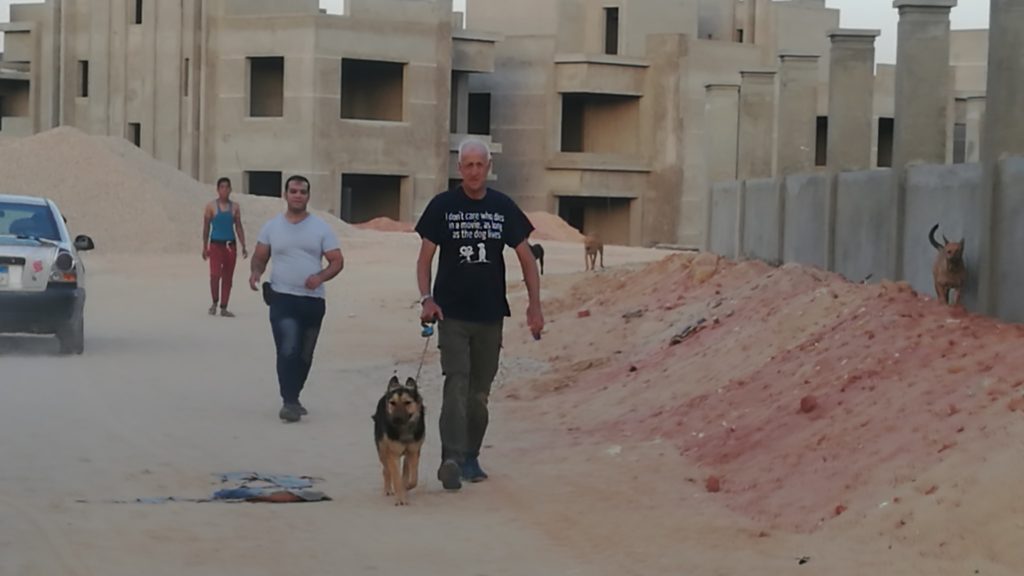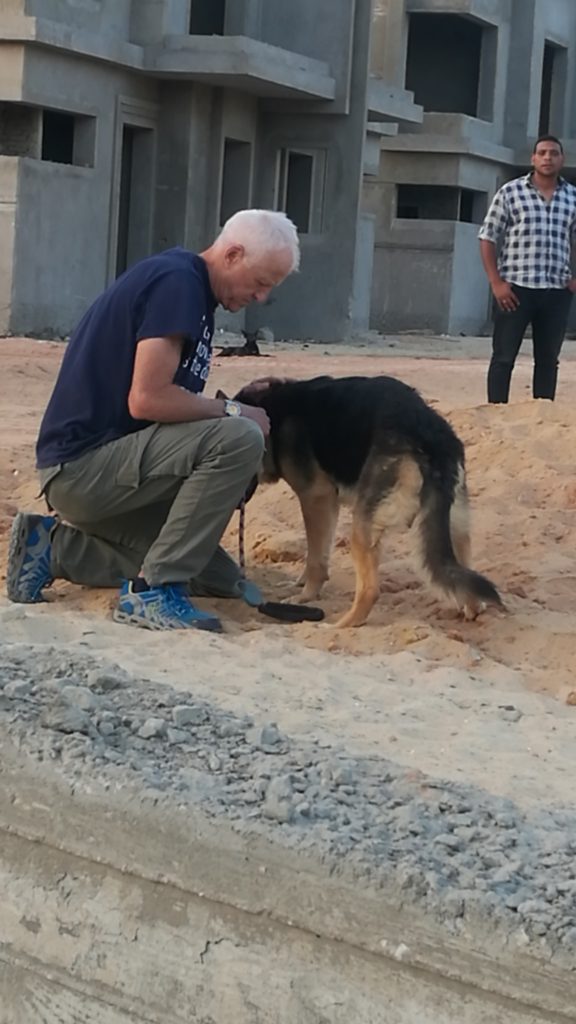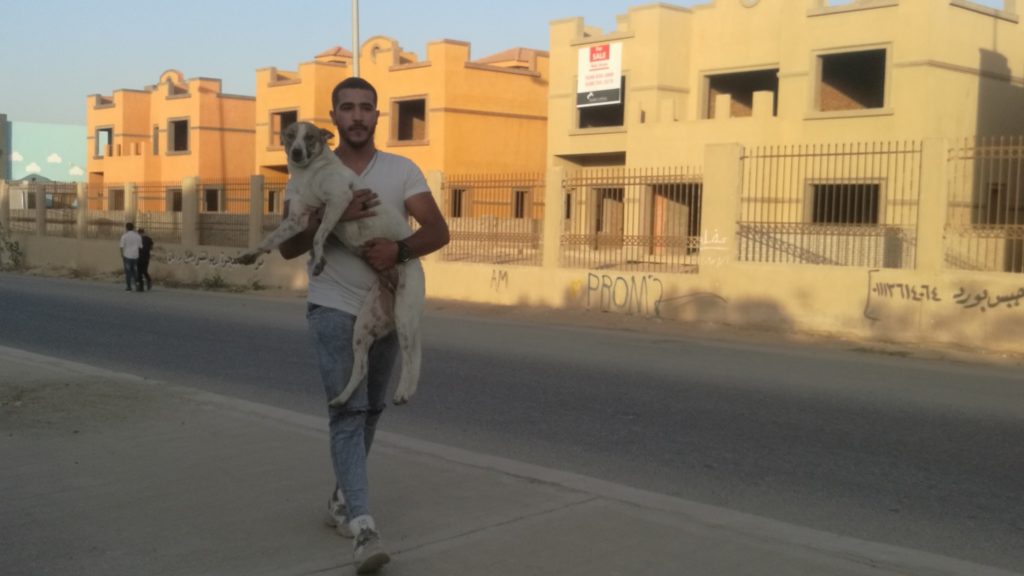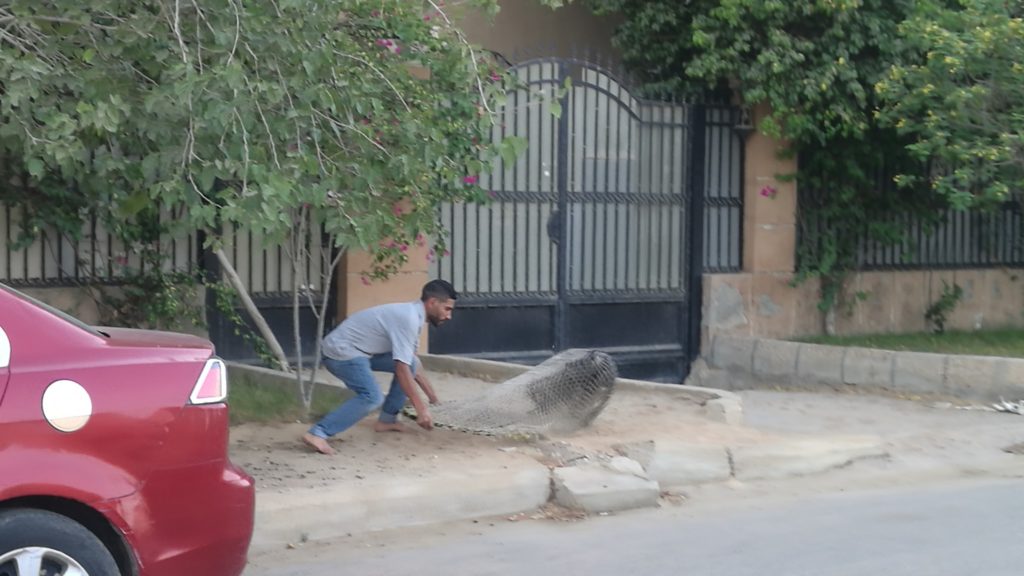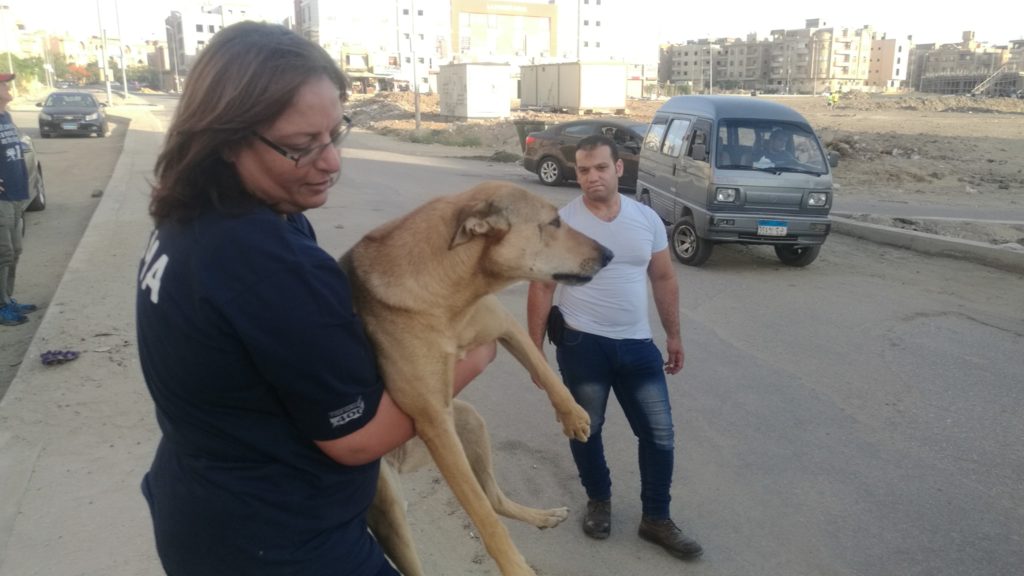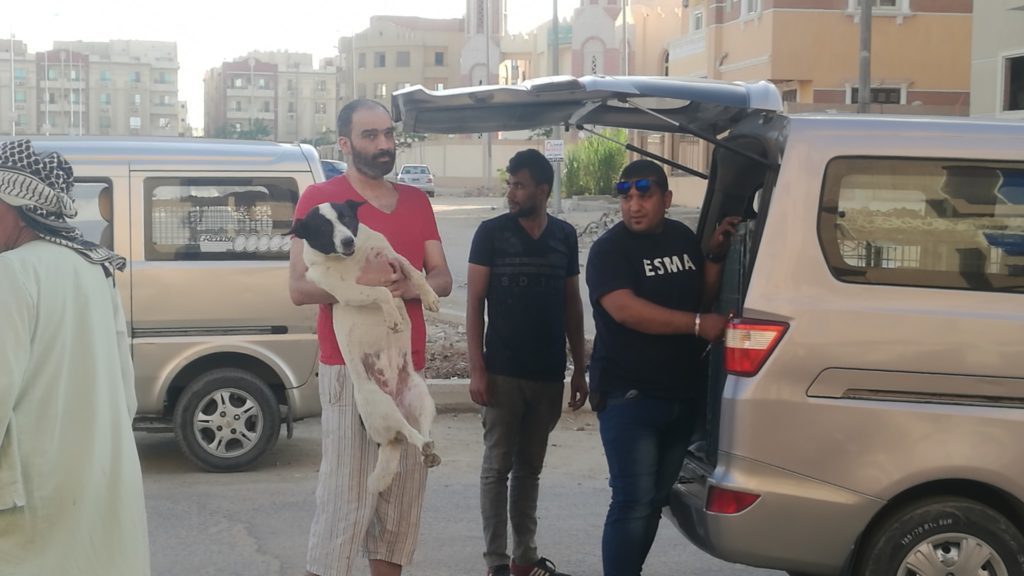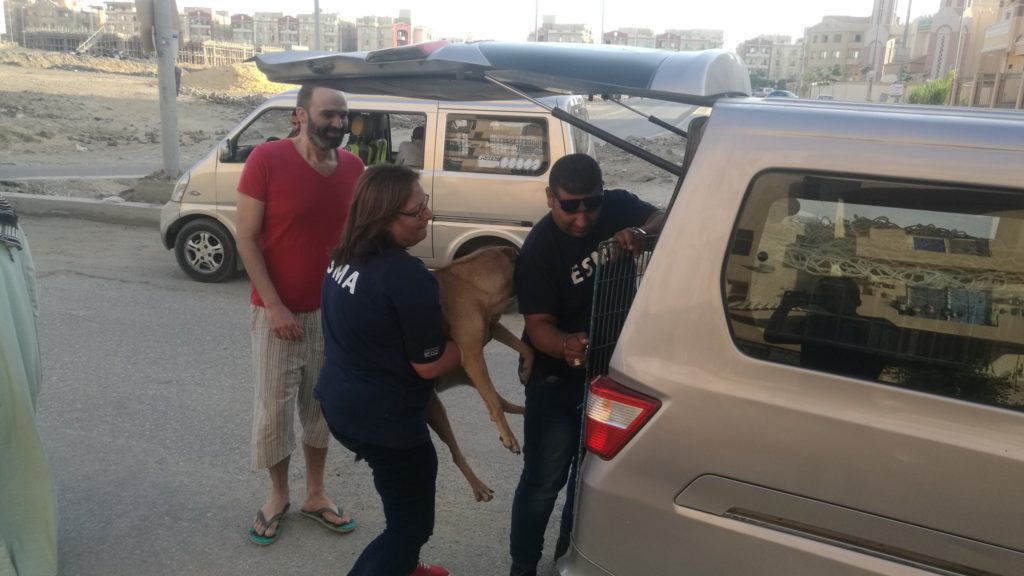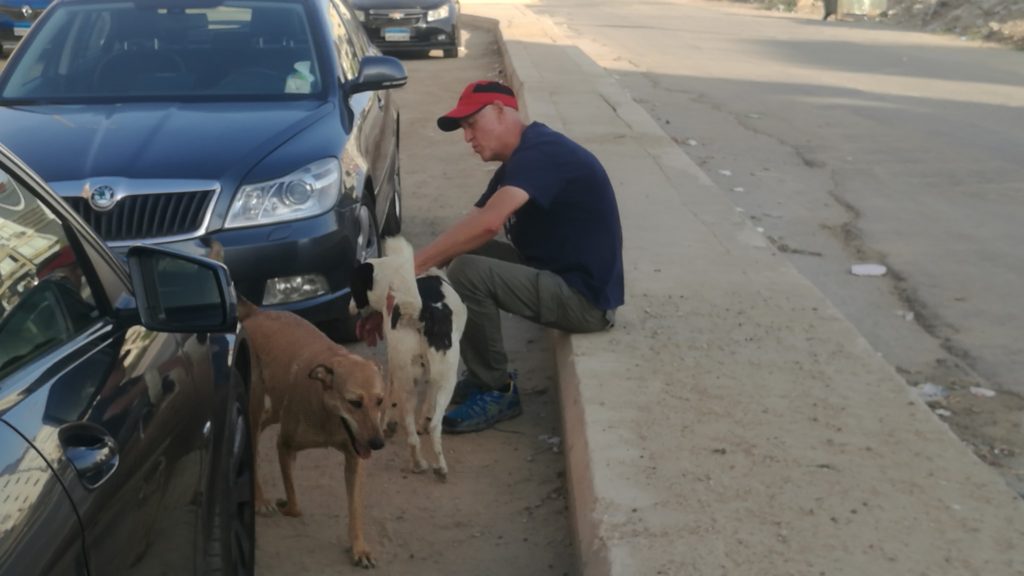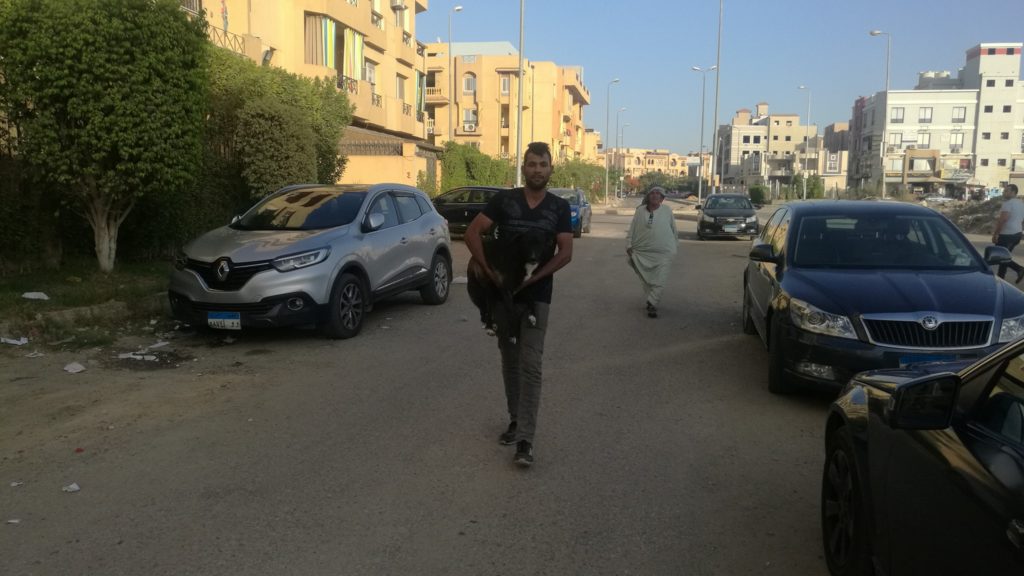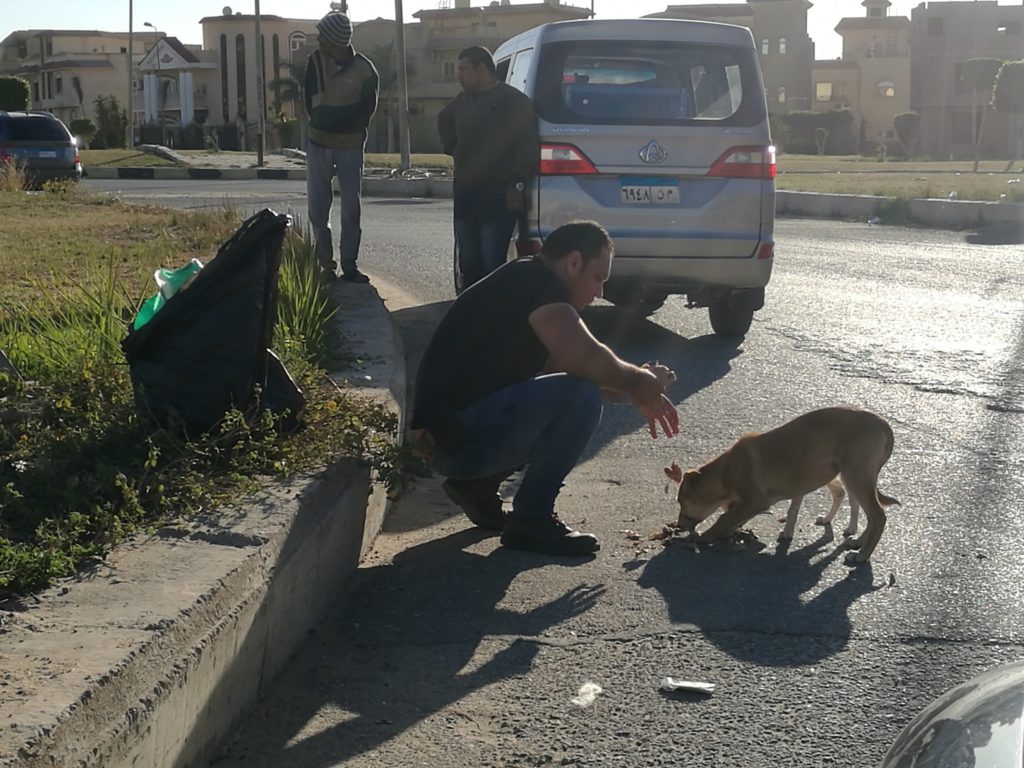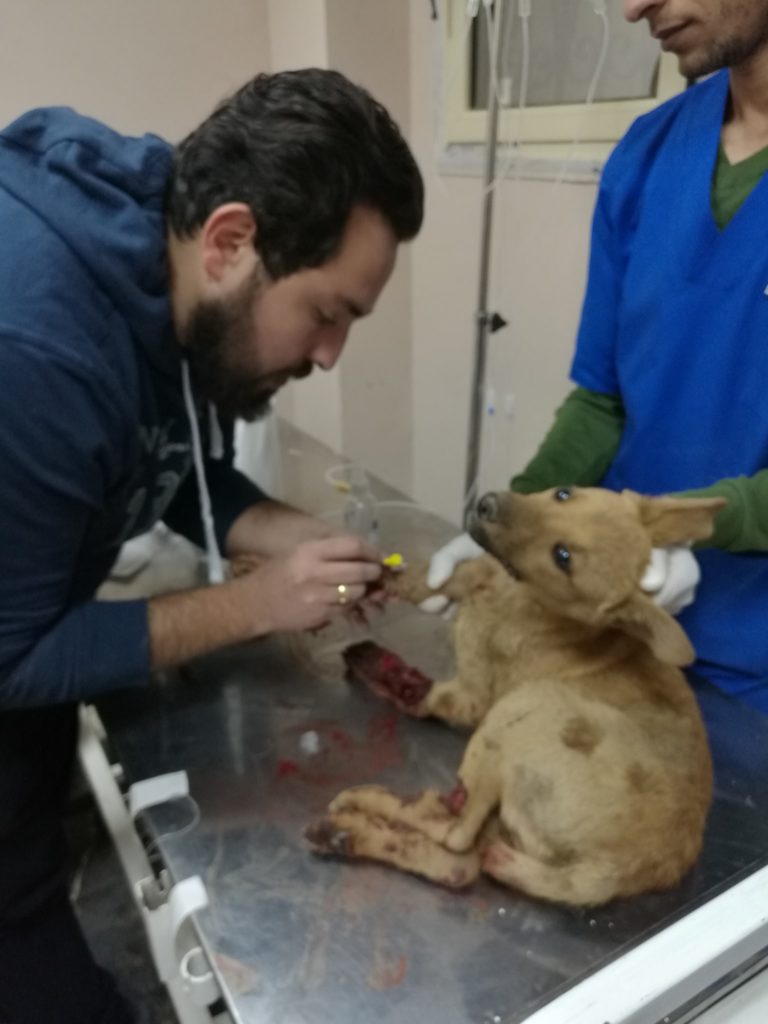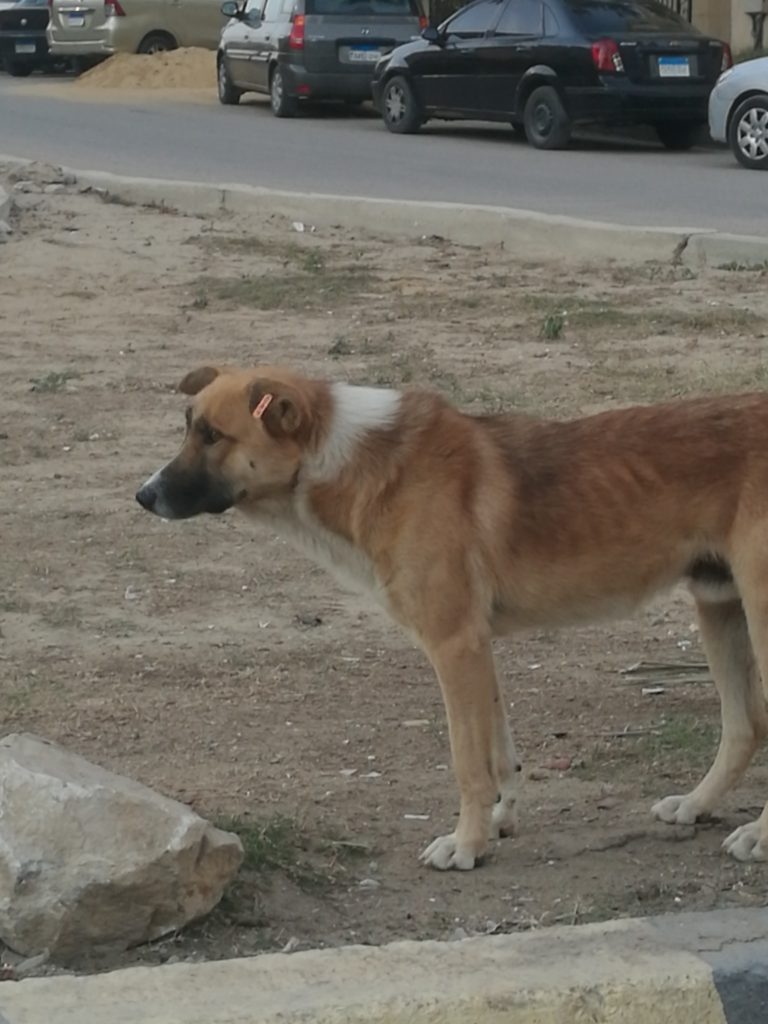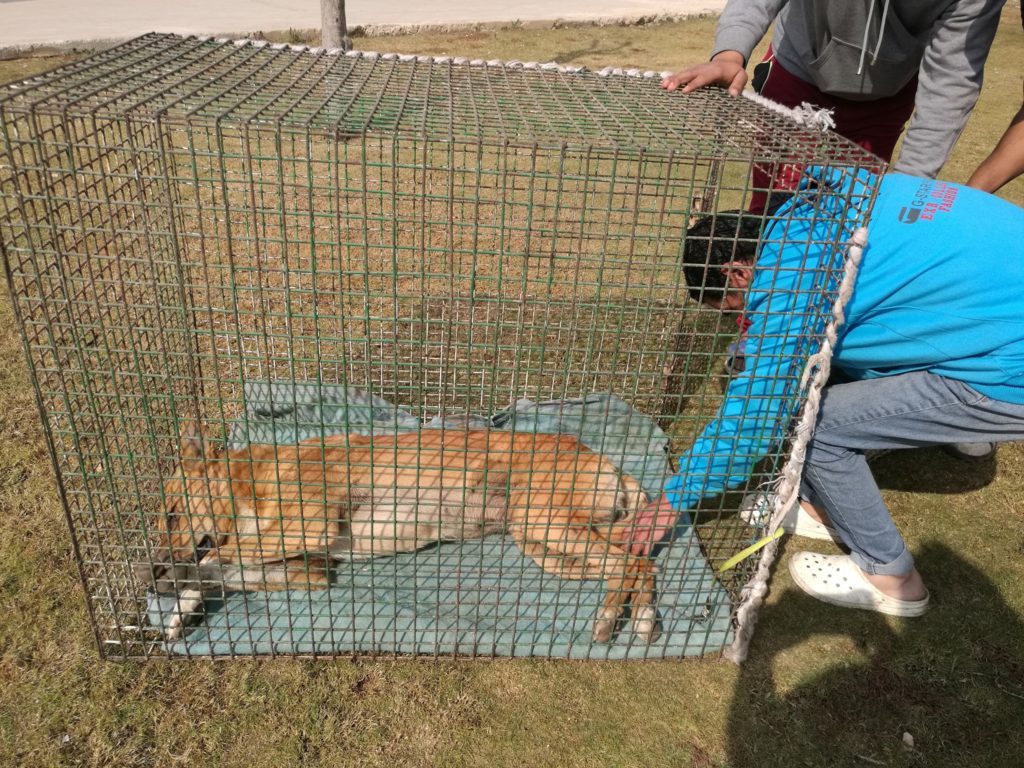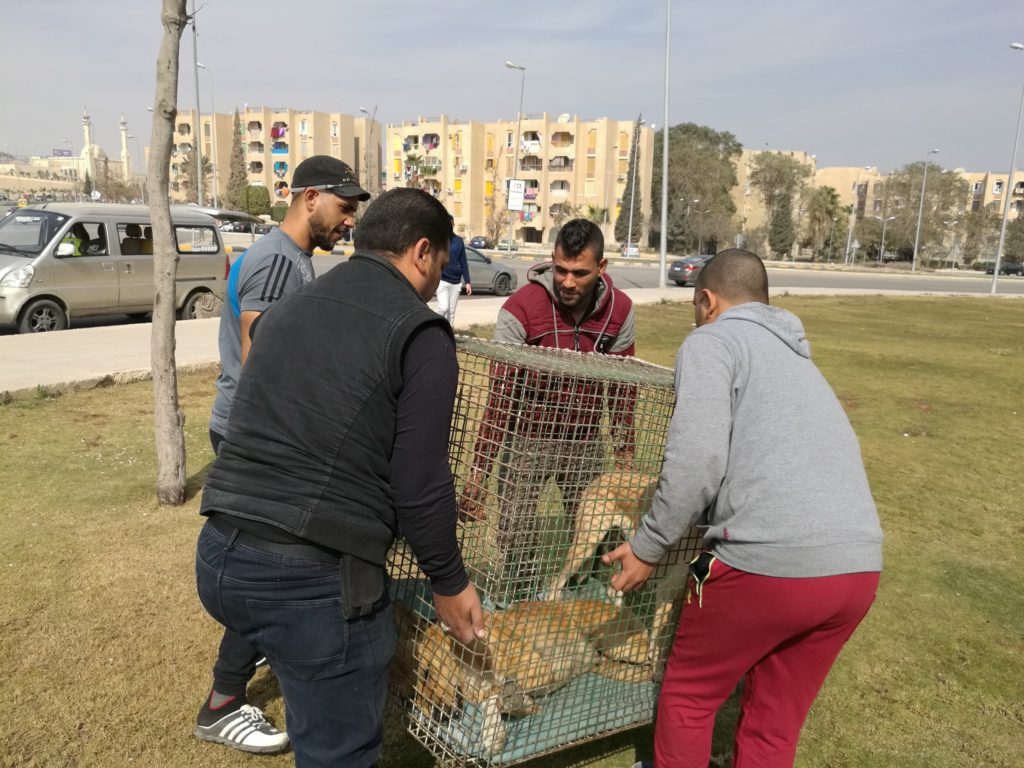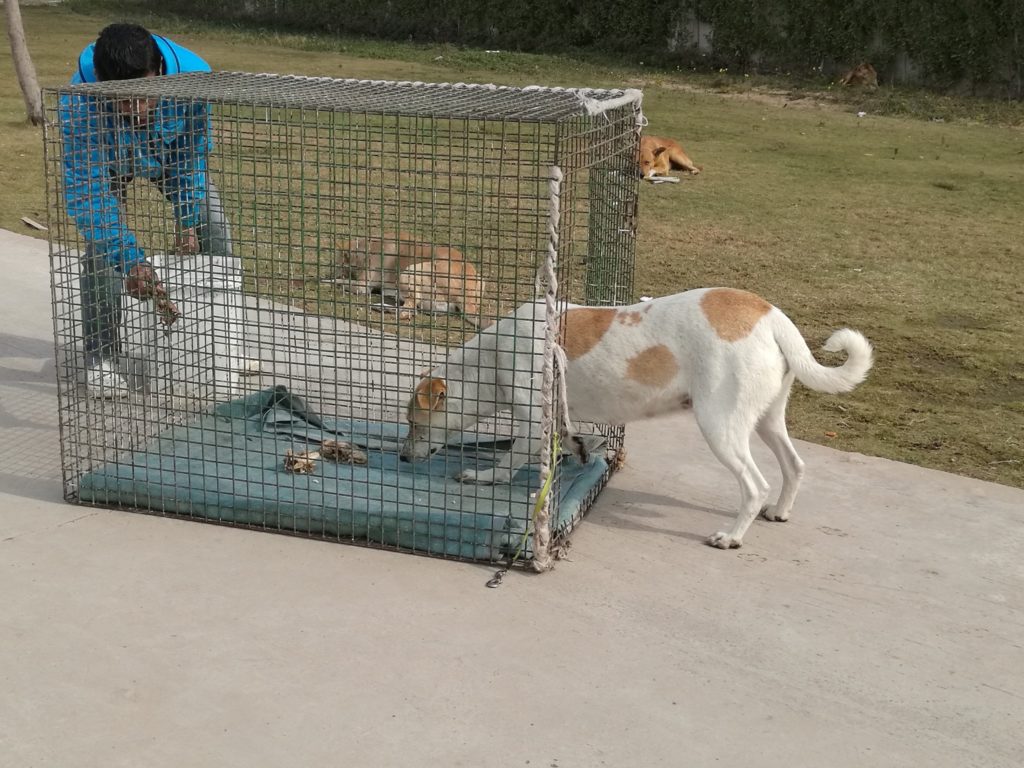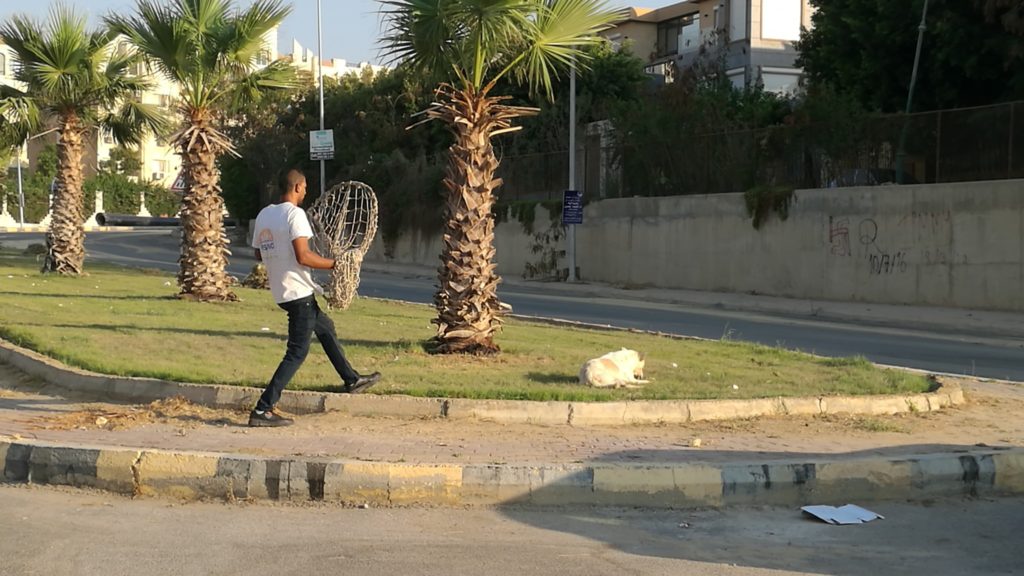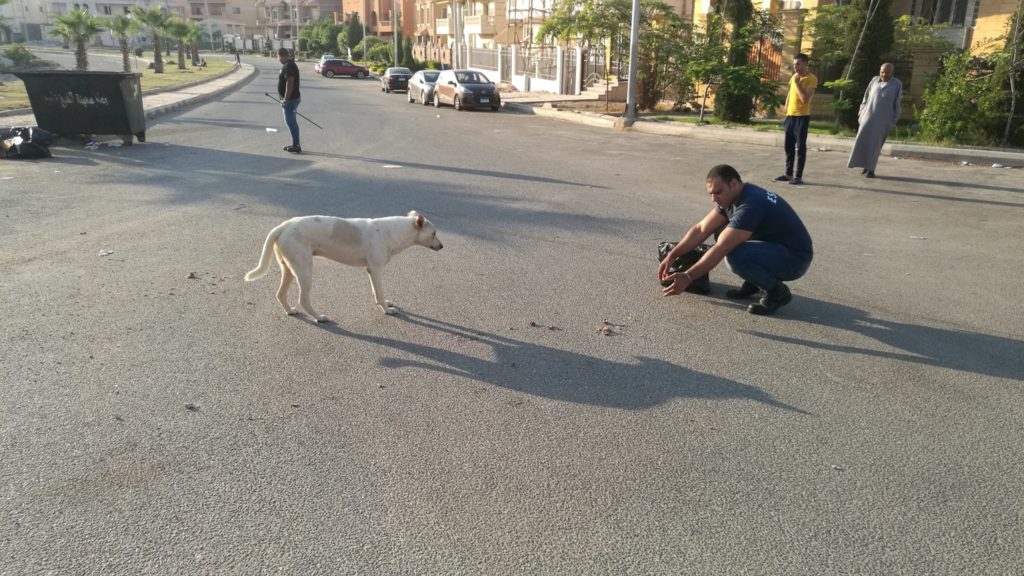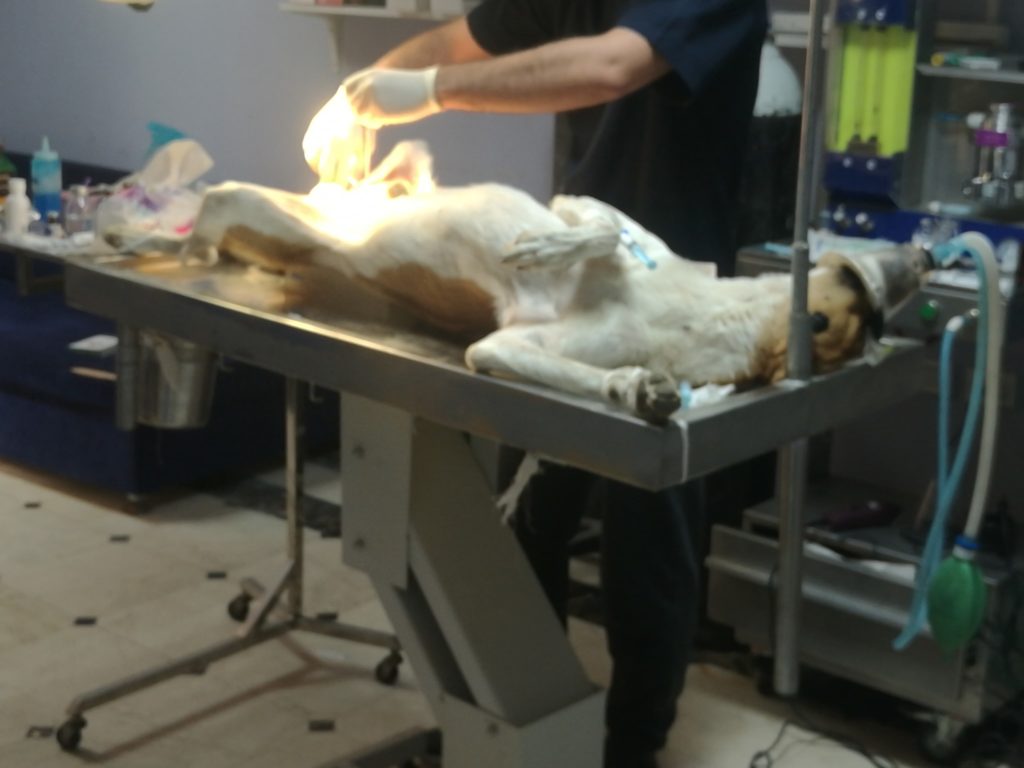Liverpool superstar Mohamed Salah has announced on Twitter that he will be donating the shirt he wore in Liverpool’s 5-0 demolition of Manchester United to an animal charity in Egypt for auction.
Archive for the ‘Reports’ Category
Equine Field Trip Report
Sunday, April 3rd, 2011Today, Wednesday the 16th of February, I went down to Nazlet El Seman to distribute the remaining of the looted sacks, as well as the locals generous donations to make up for the lootings (36 sacks total). Unfortunately the other volunteers could not make it, as they were busy in preparation for a surprise visit from a very special guest the coming day. But I was not alone, as I had the aid and support of many local horse stables.
I arrived at Sondos Stables at 11 AM, and we set up our booth and prepared for distribution. Within minutes there were over 20 horse owners with their horses lined up to receive rations. The remaining of the looted sacks (10 sacks) finished within the first 30 minutes of distribution, and had it not been for the generous 26 sacks that the locals gathered, donated, and prepared, we would have had a serious shortage.
We managed to distribute almost 300 meals for the animals, and had to turn dozens of horses away as the food supply had depleted in under 4 hours. We are in dire need of funding for food! If it weren’t for the locals donations and tremendous effort with preparing and distributing the food, today would have not been possible, and I am unsure how many of the animals, horses particularly, would have made it through the night. It was truly inspirational to see their appreciation, organization, hard work, and their willingness to have an improved and sustainable system.
To achieve this system, I believe we need to continue to provide treatments and feeds until the economy and the tourism industry start to recover. Once life starts to return to normal in terms of income for the locals, we should start to gradually withdraw the emergency aid, as they become capable of providing for their families and animals on their own.
In the mean time it is important to start an educational campaign teaching the locals the proper care for their animals, and to emphasize the relation between a healthy animal and more income. The animals are still very emaciated, and many still have wounds that need to continue being treated. Once the large organizations are fully committed to manage and handle this hige feeding and treatment operation, ESMA can start the education campaign with the leadership of Beth Sartain.
Before leaving Nazlet El Seman, I decided to pay a visit to the infamous “Graveyard”. It was very upsetting to see that besides all of our efforts, there were more fallen. There were 6 fresh corpses, some covered with Hay in an attempt to hide the body. Although a massive improvement from the original 50 horses found, it as an indication that still more efforts, medical care, and food is needed.
We will be distributing more rations and treating more animals again on Friday morning, as of 10 30 AM onwards. Pictures and updates promised as always.
Thank you to all of you following us and supporting our work.
Alaa Sharshar
Deputy Volunteer Coordinator – ESMA
www.esmaegypt.org
Pictures available on our Facebook group:
http://www.facebook.com/esma.egypt
Equine Field Trip Report
Saturday, April 2nd, 2011My name is Beth Sartain. I am a riding instructor here in Cairo. I trained in the UK and also spent many years working as a veterinary nurse. I have lived in Cairo for 5 years and in this time have always owned horses here so know many people in local stables. I stayed in Cairo during the Revolution and as soon as it was safe for me to get to my stables I did so. What I found horrified me. The tourists had all left Egypt leaving the local stable owners with no income and therefore no feed for their animals. Many were in desperate need of feed and sadly, many animals had already died. Many of the horses used for tourists here are not in good condition anyway. Many are malnourished, have overgrown hooves, sores and infections etc. The owners need help and education.
I started to ask friends on Facebook, both here in Egypt and Internationally, for help so I could maybe start a fund to buy feed for these animals. When I rode around the local area and realised the scale of the situation I then asked ESMA for help and they said yes straight away.
We started to raise funds with donations being collected by ESMA. We collected enough money to order a truck load of bran, chaff and maize which we had delivered to the IEC stables. We all met there and distributed the food to approx 450 horses that day. The owners brought the horses, we checked their condition, checked the owners ID and they signed for 2 days food per animal. The owners were so grateful.
On the 15th February we received our second load of feed. This time we had ordered 2 loads of feed so decided to distribute from 2 points, to reach as many starving horses as we possibly could. Our first feed of the day was given to 12 horses, which had actually been abandoned by their owners at our feed donation point, as they simply had nothing left to feed them. These horses were in very bad condition and we were told they had not been fed for several days. We also gave feed to 40 horses that the military were supposed to collect from the IEC stables but because of the Revolution they never came for them. These horses are now being fed by ESMA.
We then loaded up an open backed truck with 40 sacks of already mixed feed. We drove into the village of Nazlet El Saman, the truck in front of several cars of volunteers from ESMA. I was in the car directly behind the truck with Susie Nassar, one of the founding members of ESMA, and my two daughters who had come along to help. People from the village on horseback had recognised us and had already started to follow the truck. When the truck slowed down to negotiate a speed bump the local people were so desperate to get feed for their animals they mobbed the truck. There were dozens of men grabbing sacks of food and trying to ride off with it. I told my children to stay in the car with Susie and ran over to the truck. I shouted at the men to stop taking the food as we were trying to help them. Some did stop but many didn’t. I noticed one man had loaded 3 sacks of food into his carriage. I was so angry I jumped into the carriage and sat on the food and told him if he wanted the food he would have to take me too. He set off at a gallop down the road with me pleading with him to stop and trying to explain to him we wanted to offer long term help but couldn’t if this was how we were treated. He listened and stopped his horse, he shouted to many of his friends who were riding past with the stolen food to stop and they did. They crowded around and listened to me as I explained that we were doing our best to help but we needed them to co-operate. The man I was with turned the carriage around and drove back to the place where the truck had been mobbed.
Word started to go around the village about what had happened. I and all the ESMA volunteers spent hours talking to people and visiting stables to explain our situation. The owners were desperate for help and saw that if they wanted long term help the food had to be returned to us. While we were waiting for the food to be returned we all kept busy by treating wounds as best we could with limited medical supplies. We also arranged for a local farrier to attend one stable whose horses hooves were desperately in need of attention. The owner simply had no cash to pay the farrier. He trimmed 10 horses feet while we were there. One of the ESMA volunteers is a homeopathic practitioner who administered as many remedies as she could to horses in need.
All the volunteers then returned to a central point in the village where people had been returning the feed too. 40 sacks were stolen from the truck in the morning. We received 28 sacks back by the afternoon and the stable owners, who did actually have enough food for their horses, then donated to us a further 26 sacks of food. They were also confident we will get more sacks returned as they now know we aim to help long term.
We set up a collection point and once again owners brought their horses, we checked owners ID, checked the horses and gave as much feed as we considered appropriate considering the condition of the horse. Out of all the ESMA volunteers present yesterday I am the only one with any equine experience so I treated any wounds I saw as best I could. When I saw horses that needed medical attention I told the owners to go The Brooke help station. Many owners told me they already had been to Brooke only to be turned away. MANY owners told me this and we have taken owners names who said they will be very willing to voice their concerns to anyone who will listen. I reported my findings to Mona Khalil, another founding member of ESMA, who telephoned Dr. Nasser Hossni who is the Director of Brooke Egypt. Mona gave me the phone and I asked why Brooke was not helping. Dr Nasser replied that Brooke were helping but not with feed only medical attention. I told Dr Nasser that I was not at all happy with this as many horses needed attention and food and Brooke should be helping so much more. I told Dr Nasser that I would be looking into this as soon as I have time. Many people donate to Brooke, I myself have in the past. I want to know where the money is being spent in Egypt.
Many of the ESMA volunteers stayed until late at night at our donation point. We have the backing of all the stable owners in the village and they know we will do all we can to help them. Many came and personally apologised to me for the chaos of earlier in the day and the whole village is coming together to help us help them. We now have a very good relationship with many owners there and we plan to continue our work after this crisis. We plan to help with education and it would be wonderful if we could introduce ESMA approved riding stables were all horses are well cared for, fed and are ridden in well fitting tack etc. This obviously is in the long term but we have set great foundations for ESMA and the horses of Egypt.
Beth Sartain, 16th February 2011 – Member and volunteer at ESMA
Equine Field Trip Report (German)
Friday, April 1st, 2011Bericht über die Exkursion von ESMA am 13. Februar 2011 zu den hungernden Pferde im Pyramiden Bereich in Kairo
An alle, die sich betroffen fühlen,
wir waren gestern vor Ort um uns selbst ein Bild von der Lage zu machen. Wir wollten Fotos machen, Einheimische interviewen und vor allem Futter verteilen. Anlass waren Berichte über unterernährte und verhungernde Pferde in Ägypten auf Grund der Unruhen. Hier ist unser Bericht einschließlich von etwa 200 Fotos:
Unsere Gruppe von sieben Freiwilligen traf sich mit Beth Sartain an ihrem Arbeitsplatz. Beth ist Reitlehrerin und in Großbritannien ausgebildete Tierarzthelferin mit langjähriger Erfahrung in der Behandlung von Pferden, Eseln und Maultieren. Wir hatten auf Empfehlung von Beth für unterernährte Tiere geeignetes Futter bestellt. Es wurde um 11:00 Uhr geliefert und von den Stallhelfern zusammengemischt: Korn, Kleie, Mais und Spreu
Die Halter der Pferde und Wagen trafen schon in Scharen ein. Wir hatten sie durch den Besitzer der Ställe informieren lassen, dass wir geringe Futtermengen an unterernährte Tiere abgeben. Wir hatten beschlossen nach folgendem System vorzugehen:
- Das Pferd wird untersucht und bekommt bei Unterernährung einen Eimer des Futtergemischs. Leider mussten wir einige zurückweisen, weil sie noch in relativ guter Verfassung waren.
- Der Halter unterschreibt pro Pferd. Name und ID-Nummer werden registriert.
- Der Halter bekommt eine Futtermenge, die das Überleben für zwei Tage sichert.
Futter auf Pflanzenbasis haben wir auf Beth’s Rat nicht angeboten. Es ist für geschwächte Tiere nicht bekömmlich und verschlimmert ihren Zustand.
Sobald die Verteilung der Nahrung gut angelaufen war, überließen wir die Aufgabe dem Stallbesitzer und begaben uns in die „touristische Zone“, wo die meisten Pferde und Wagen zu finden sind. Kein einziger Tourist war in Sicht. Es sah aus wie in einer „Geisterstadt“. Beth führte uns zum „Friedhof“. Dort hatte sie vor ein paar Tagen sterbende und tote Pferde gesehen.
Kurz bevor wir ankamen, sahen wir eine Stallanlage, aus der gerade ein totes Pferd abtransportiert wurde (siehe Foto). Wir baten um Zutritt und erklärten, wir kämen von der Animal Welfare Society und wollten uns ein Bild vom Zustand der Tiere machen. Man ließ uns gerne ein. Der Anblick war erschütternd. Die meisten Tiere waren extrem unterernährt und einige offensichtlich krank. Der Besitzer sagte, er habe kein Geld die Tiere zu füttern und behandeln zu lassen. Wir verwiesen ihn an unsere Verteilungsstelle, dort solle er Futter für seine Pferde abholen.
Dann setzten wir unseren Weg zum „Friedhof“ fort. Der Anblick war deprimierend. Einige unserer Freiwilligen konnten die Tränen nicht zurückhalten. Da lagen mindestens 50 Kadaver, die meisten stark aufgedunsen. Wie mir Beth sagte, sind das die erst vor Kurzem verendeten. Wir fanden auch Kadaver von 3 Kamelen. Wie wir später von den Besitzern erfuhren, waren sie verhungert. Am Verstörendsten war der Anblick der Fohlen, die tot neben ihren Müttern lagen.
Es war an diesem Ort, wo wir mit den ansässigen Haltern ins Gespräch kamen. Wir geben im Folgenden einiges von dem wieder, was wir erfahren haben:
Unter normalen Umständen bekommen die Pferde eine Mischung aus Mais, Kleie, Spreu und Klee.
Die Zahl der Pferde in dieser Gegend wird auf 3000 geschätzt, die der Kamele auf 500.
Die meisten können ihre Tiere nicht mehr ernähren, viele nicht einmal ihre Kinder. Ihre Einkommensquellen sind völlig versiegt.
Sie können ihre Kinder nicht mehr in den Kindergarten schicken.
Brooke ist nur in einem Gebiet aktiv, anscheinend auch nur sonntags. In den meisten Gebieten sind sie nicht zu finden. Die Pferdehalter müssen zu ihnen kommen. Seit zwei Tagen haben sie keine Spritzen. Sie behandeln lieber Esel und Maultiere als Pferde. Wenn sie Pferde in ihr Haupthospital aufnehmen, wird gewöhnlich entschieden sie zu euthanasieren. Deswegen wollen die Halter sie nicht dorthin bringen. Sie glauben, dass dieser drastische Schritt in den meisten Fällen nicht gerechtfertigt ist. Es sei eben die einfachere Lösung.
Der zuständige Amtstierarzt ist korrupt. Der Amtstierarzt soll eigentlich immer nur ein Jahr für einen Bezirk zuständig sein. Der gegenwärtige Amtsinhaber ist aber schon ca. 20 Jahre im gleichen Bezirk. Er verlangt immer Bezahlung, obwohl die Behandlung eigentlich kostenlos sein soll. Dasselbe gilt für Medikamente. Er verkauft sie zu Wucherpreisen.
Ein Halter hat allein in dieser Woche 5 Pferde durch Verhungern verloren.
Zu normalen Zeiten füttern sie ihre Pferde dreimal am Tag.
Keiner der Gesprächsteilnehmer hatte etwas dagegen, uns seinen Namen und seine Nummer zu nennen, im Gegenteil. Sie waren froh, ihrem Ärger Luft machen zu können.
Der Stallbesitzer, der uns freundlicherweise half die Fütterung zu organisieren, hat zusätzlich 55 herrenlose Pferde zu versorgen. 40 sollten an das Militär und an die Polizei gehen, wurden aber nicht abgeholt. Die anderen hatte er verkauft, beschloss aber gestern sie zurückzunehmen, weil er es nicht ertragen konnte sie in einem so jämmerlichen Zustand zu sehen. Er kann diesen verwaisten Tieren nur das absolute Minimum an Futter geben, das sie zur Lebenserhaltung brauchen, da er zur Zeit selbst kein Einkommen hat. Die meisten der wohlhabenden Pferdebesitzer und Expats haben Ägypten gleich zu Beginn der Krise verlassen, ohne ihm Geld (die Banken waren alle geschlossen) für den Unterhalt ihrer Tiere zu hinterlassen.
Meine Stellungnahme
Das Problem ist gewaltig und es ist unlösbar, wenn große Organisationen nicht zur Hilfe kommen.
Die Zahl der betroffenen Pferde und Kamele, die schon genannt wurde, bezieht sich nur auf ein kleines Gebiet und nicht auf ganz Kairo oder ganz Ägypten.
Die Krise wird andauern, bis der Tourismus sich erholt, was in den nächsten Monaten nicht wahrscheinlich ist. Der Zustand der Pferde wird sich verschlimmern, solange niemand zur Hilfe kommt.
Wir von ESMA sind eine kleine Organisation, verstehen fast nichts von Huftieren und haben nur sehr begrenzte Ressourcen. Wir sind längerfristig nicht in der Lage den Pferden, Eseln, Maultieren und Kamelen zu helfen. Wir bekommen Spenden, aber es wird nie genug sein um die Versorgung so vieler Tiere zu sichern.
Gestern konnten wir aus lokalen Spenden 450 Pferde füttern. Menschen aus dem Ausland haben angefangen zu spenden. Aber es dauert offensichtlich bis das Geld ankommt. Wir mussten viele hungrige Tiere abweisen. Der Stallbesitzer hat uns berichtet, dass noch viele kamen, nachdem wir gegen 16:00 Uhr den Stall verlassen hatten und nichts mehr übrig war. Es war sehr traurig, aber die Pferdehalter haben die Situation mit Würde getragen und verstanden, dass die schlimmsten Fälle Vorrang haben mussten.
Futtermengen nach Auskunft von Beth und dem Stallbesitzer
Ein durchschnittliches Arbeitspferd braucht unter normalen Bedingungen die folgenden Mengen pro Tag. Wenn das Tier nicht arbeitet, braucht es sehr viel weniger um zu überleben.
6 kg hartes Futter, eine Mischung aus Mais, Kleie und Spreu
zusätzlich (nur für gesunde Tiere) 25 kg Barseem, eine Art Klee
aktuelle Großhandelspreise (seit Beginn der Krise haben sich die Preise verdreifacht)
1 Tonne Barseem LE 250
1 Tonne Spreu LE 1000
140 kg Mais LE 310
Heu und Gerste sind teuer und werden gewöhnlich nicht gekauft.
Dank großzügiger Spenden von meist lokalen Spendern, aber es sind auch ein paar internationale dabei, werden wir morgen eine zweite Fütterung anbieten können. Hoffentlich können wir noch mehr Pferde und Kamele als gestern versorgen.
Dieser Bericht ist nicht für eine bestimmte Organisation oder Einzelperson bestimmt. Er informiert über die Zustände, die ESMA gestern vorgefunden hat. ESMA begrüßt es, wenn der Bericht weitergegeben wird, um so viel Bereitschaft wie möglich zu wecken den verhungernden Pferden zu helfen.
Vielen Dank für Eure Zeit
Susie Nassar
ESMA Gründungsmitglied (www.esmaegypt.org oder bei facebook unter ESMA)
PS. Soeben hat Beth Sartain mitgeteilt, dass 500 Halter bei den Ställen erschienen sind in der Hoffnung hier heute Futter für ihre Tiere zu bekommen. Jeder hat mindestens zwei Pferde, das macht 1000 hungrige Tiere.
Equine Field Trip Report
Friday, April 1st, 2011Here is the report on yesterday’s ‘Field Trip’ to investigate for ourselves the situation, take pictures (nearly 200), interview locals, and most importantly distribute food regarding reports of ‘starving and malnourished horses in Egypt’ due to the recent turmoil:
Our volunteer group (group of seven), met up with Beth Sartain at the stables she works at (Beth is a British Riding Instructor and U.K. trained Veterinary Nurse (with many years of experience treating equines). The food that we had ordered on Beth’s recommendation (suitable for the condition of the malnourished horses), arrived at 11 a.m. The stable hands mixed all the various components together – grain/bran/maize and chaff.
The horse and cart ‘owners’ had already started to arrive ‘thick and fast’. We had informed them (through the Stable owner) that we would be offering minimal amounts of food for ‘malnourished horses’. We had already decided to set up a system of :
-Horse is inspected, if malnourished would be given the ration of one bucket of mixed food per horse. Unfortunately we had to turn away a few as they were deemed to be ‘in reasonable condition’.
-Owner signs up for food, per horse, name is recorded and ID number registered.
-Owner is then handed over the minimum amount to keep the horse alive for two days.
We did not (on Beth’s advice, give the serious cases plant base feed as Beth advised it will ‘worsen their condition’, and play havoc with their already highly sensitive digestive system in the condition they are in.
When the system of food distribution was well under way, (which we left in the hands of the stable owner), we moved on to investigate the ‘touristic area where most of the horses and carts are concentrated. There was not one single tourist in sight, in fact it looked like a ‘ghost town’. Beth was leading us to the ‘graveyard’ where she had seen a few days ago, the sight of the dead and dying horses.
Just before we got there we stopped as we saw a stable facility carting out a dead horse (amongst the pictures attached). We asked if we could go inside and see the condition of the rest of the horses. We explained that we were from an Animal Welfare Society and they gladly let us in to see the conditions oursleves. The scene was devastating….most of the horses were extremely malnourished and some were obviously sick. The owner told us he had no money to feed or treat them. We told the owner to go to the distribution point and collect rations for his horses.
WE then moved on to ‘The graveyard’. The scene was extremely depressing, some of our volunteers could not control their tears.
There were at least 50 carcasses, most of them in ‘the bloated stage’ and Beth informed me those were the ones that had died most recently. We also found the carcasses of 3 camels, which we knew later from the owners had ‘starved to death’. The most distressing of all the dead animals were the dead foals lying next to their mothers…
It was here that we had the conversations with the local horse and cart owners.
Below are some parts of the conversations with them :
- The horses in normal conditions would usually be fed a combination of maize/bran/chaff and barseem (clover).
- Horse owners believe the horse population in this area to be around 3000, they estimate about 500 camels.
- Most could no longer feed their animals or even their families, their source of income has completely dried up…..
- They could also no longer send their children to nursery schools
- ‘Their statements’ – “Brooke are only stationed in one area, and apparently are there only on a Sunday….they do not mobilise themselves in most of the areas. The horse owners have to go to them. For the last two days they have had ‘no syringes’ (we heard this from many horse owners). All said The Brooke are more inclined to treat donkeys and mules rather than horses. When they do take the horses for treatment at the main hospital premises , the usual decision is to eauthanise them. They claimed that is why they do not like taking them there as they do not believe this drastic decision is neccessary in most cases, just an ‘easier’ solution for them”.
They claimed that the ‘Government assigned Vet’ was corrupt. They also claimed the ‘Government assigned Vet’ is only supposed to be assigned to any one area for a one year period. The current vet has been in the area for nearly 20 years…..They informed us that he should treat the horses for free, but always asks for money. The same applied for medications; he would sell them medications at exorbitant prices.
Another horse owner told us how he had lost five of his horses to starvation this week alone. They usually feed their horses three times per day in normal circumstances. None of the owners interviewed objected to giving out their names and numbers, and were in fact very eager to vent their frustrations….
Other notes/observations :
- When the horses were waiting in line for their rations, some of them were ‘so hungry’ they ate the trees.
- The stable owner who kindly helped us organise this ‘feeding’, also has had 55 horses ‘dumped’ on him. 40 of them were due to go to the Military and Police forces but were never collected. The others he decided to take them back yesterday (previously sold by him) as he could not bear to see the pitiful condition they were in. He can only give these ‘orphaned horses’ the bare minimum to keep them alive as he himself has no income, since most of the ‘wealthy horse owners’ and expats had left Egypt at the beginning of the crisis and not left him funds to cover their expenses, (bear in mind all the Banks were at that time, shut).
My comments/opinion :
- The problem is ‘enormous’ and completely unsustainable unless a big organisation/organisations steps in to save them.
- The estimated number of horses and camels that I quoted earlier do not include any other areas of Cairo/Giza or other areas nationwide!
- This will be an ongoing crises until tourism starts up again (not likely in the coming months). The horses will deteriorate further and further if someone does not step in to save them.
- We, as a small organisation with almost zero knowledge of equines, and very limited resources are unable to help these horses in the long term. People are donating but it will never be enough to sustain the numbers and quantity of food needed.
- Yesterday with the grateful donations received locally we were able to feed around 450 horses. People have started to donate internationally but obviously their donations dedicated to this appeal will take time to come through. We had to turn many away and were informed by the stable owner that many more turned up after we left around 4pm and they had no more food to give them. It was a pitiful sight, but I have to say that the horse owners retained their dignity throughout this and understood that the worst cases had to be given priority.
Facts on feeding according to Beth/Stable owner’s recommendations :
An average working horse needs the following in normal conditions, but can survive on much less if not working.
Per day :
6kg of ‘hard’ food – consists of a mixture of maize/bran/chaff
In addition (for healthy horses only) 25kg per day of Barseem (local clover)
Current market prices from wholesalers (feed prices have tripled since the crisis began) :
One ton of Barseem = LE250
” ” chaff = LE1000
140kg of maize = LE 310
Hay and barley are expensive so people do not usually buy them.
Tomorrow, again due to generous donations from mostly local donors (and a couple of international donors) we will make our ‘second feeding’. We hope to be ale to increase the number of horses/camels that we fed yesterday.
For everyone’s information this report is not exclusively intended for any particular individual or organisation. it is a general report and findings of the conditions as ESMA witnessed yesterday. ESMA allows this report to be passed on to any third party to generate as much awareness and support as possible to aid these starving animals.
Thank you for your time,
Susie Nassar
ESMA Founding Member
www.esmaegypt.org
PS. Just before sending this report, ESMA has been informed by Beth Sartain that 500 horse and camel owners turned up at the stables hoping that there would be food for their animals today (the minimum that each horse owner has is 2 horses, ie. 1000 animals).


 page
page




